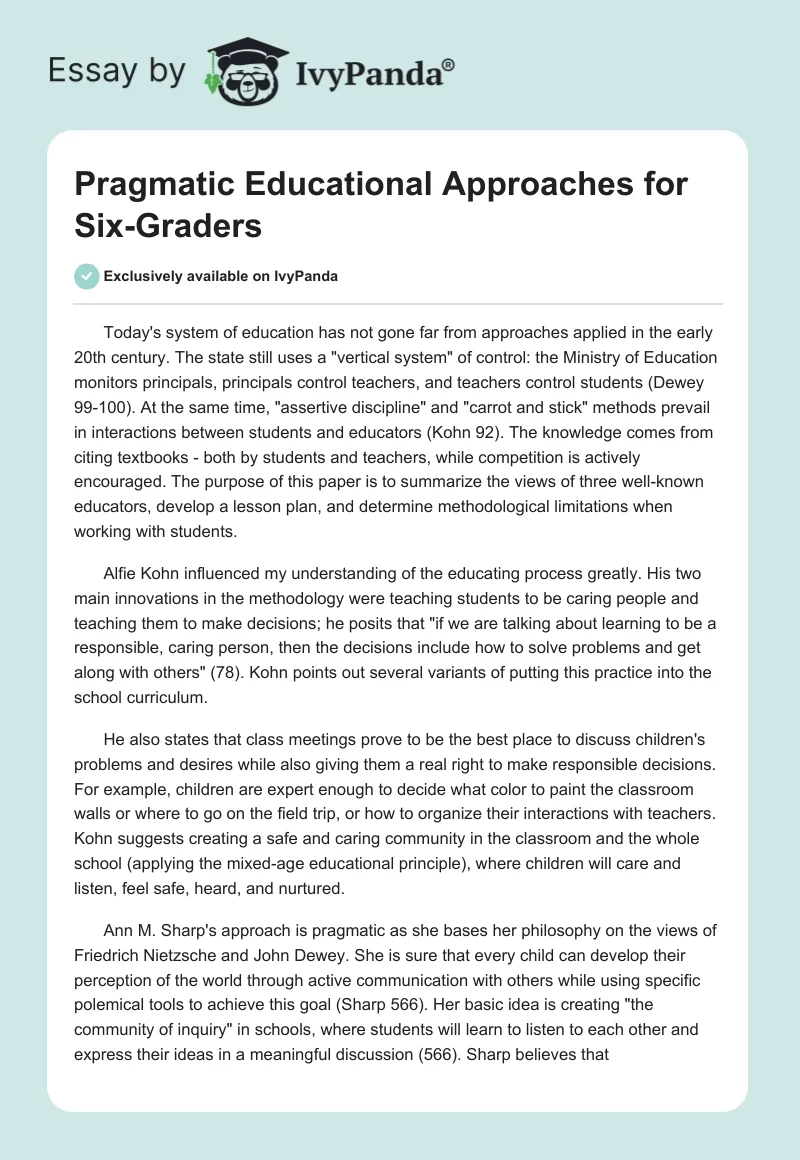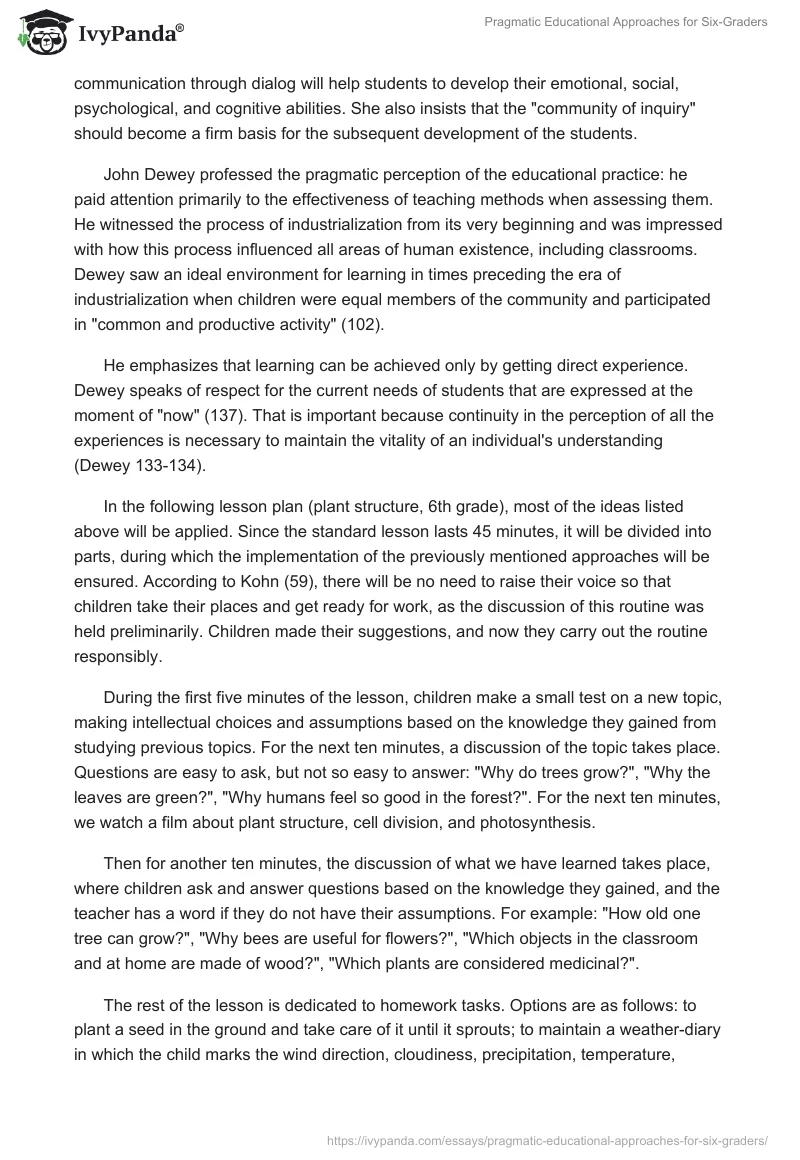Today’s system of education has not gone far from approaches applied in the early 20th century. The state still uses a “vertical system” of control: the Ministry of Education monitors principals, principals control teachers, and teachers control students (Dewey 99-100). At the same time, “assertive discipline” and “carrot and stick” methods prevail in interactions between students and educators (Kohn 92). The knowledge comes from citing textbooks – both by students and teachers, while competition is actively encouraged. The purpose of this paper is to summarize the views of three well-known educators, develop a lesson plan, and determine methodological limitations when working with students.
Alfie Kohn influenced my understanding of the educating process greatly. His two main innovations in the methodology were teaching students to be caring people and teaching them to make decisions; he posits that “if we are talking about learning to be a responsible, caring person, then the decisions include how to solve problems and get along with others” (78). Kohn points out several variants of putting this practice into the school curriculum.
He also states that class meetings prove to be the best place to discuss children’s problems and desires while also giving them a real right to make responsible decisions. For example, children are expert enough to decide what color to paint the classroom walls or where to go on the field trip, or how to organize their interactions with teachers. Kohn suggests creating a safe and caring community in the classroom and the whole school (applying the mixed-age educational principle), where children will care and listen, feel safe, heard, and nurtured.
Ann M. Sharp’s approach is pragmatic as she bases her philosophy on the views of Friedrich Nietzsche and John Dewey. She is sure that every child can develop their perception of the world through active communication with others while using specific polemical tools to achieve this goal (Sharp 566). Her basic idea is creating “the community of inquiry” in schools, where students will learn to listen to each other and express their ideas in a meaningful discussion (566). Sharp believes that communication through dialog will help students to develop their emotional, social, psychological, and cognitive abilities. She also insists that the “community of inquiry” should become a firm basis for the subsequent development of the students.
John Dewey professed the pragmatic perception of the educational practice: he paid attention primarily to the effectiveness of teaching methods when assessing them. He witnessed the process of industrialization from its very beginning and was impressed with how this process influenced all areas of human existence, including classrooms. Dewey saw an ideal environment for learning in times preceding the era of industrialization when children were equal members of the community and participated in “common and productive activity” (102).
He emphasizes that learning can be achieved only by getting direct experience. Dewey speaks of respect for the current needs of students that are expressed at the moment of “now” (137). That is important because continuity in the perception of all the experiences is necessary to maintain the vitality of an individual’s understanding (Dewey 133-134).
In the following lesson plan (plant structure, 6th grade), most of the ideas listed above will be applied. Since the standard lesson lasts 45 minutes, it will be divided into parts, during which the implementation of the previously mentioned approaches will be ensured. According to Kohn (59), there will be no need to raise their voice so that children take their places and get ready for work, as the discussion of this routine was held preliminarily. Children made their suggestions, and now they carry out the routine responsibly.
During the first five minutes of the lesson, children make a small test on a new topic, making intellectual choices and assumptions based on the knowledge they gained from studying previous topics. For the next ten minutes, a discussion of the topic takes place. Questions are easy to ask, but not so easy to answer: “Why do trees grow?”, “Why the leaves are green?”, “Why humans feel so good in the forest?”. For the next ten minutes, we watch a film about plant structure, cell division, and photosynthesis.
Then for another ten minutes, the discussion of what we have learned takes place, where children ask and answer questions based on the knowledge they gained, and the teacher has a word if they do not have their assumptions. For example: “How old one tree can grow?”, “Why bees are useful for flowers?”, “Which objects in the classroom and at home are made of wood?”, “Which plants are considered medicinal?”.
The rest of the lesson is dedicated to homework tasks. Options are as follows: to plant a seed in the ground and take care of it until it sprouts; to maintain a weather-diary in which the child marks the wind direction, cloudiness, precipitation, temperature, atmospheric pressure; making ikebana. Students can choose both options and receive twice as many stars. If they want, they can also conduct a practical task in the next lesson together and with my guidance. They can even do the job twice – both at home and during the lesson, for which they will also get the stars. Thus, stars are awarded more for students’ participation and involvement than for the complexity of the task.
There are two main limitations to the teacher’s approach: limitations in gaining experience and limitations in implementing conventional discipline. Traditional discipline is not applied during this lesson because it is not necessary. Dewey emphasizes that “…teacher can arrange conditions that are conducive to community activity… which exercises control over individual impulses by the mere fact that all are engaged in communal projects” (143).
He gives an example of “social control,” describing children playing a “four square,” when they control each other, following certain generally accepted rules (Dewey 139). He also notes that younger children tend to change the rules if older children or adults change them. At the same time, Kohn notes the importance of the sympathetic interest of the adults in the community since an adult, particularly a teacher, is a role model (111-113).
Limitations in gaining experience may arise because educational institutions cannot always offer opportunities for a broader and more direct process of learning. Another lesson on this topic could be held in the school greenhouse, schoolyard, or park. The laboratory work will not bring much pleasure and benefit to the students of the 6th grade, although they, of course, will be interested in getting acquainted with various measuring instruments or the process of maintaining an observation log.
Thus, school education was examined through the prism of the philosophy of three famous educators, a lesson plan was developed, and methodological limitations were discussed. The creation of a caring and safe community is one of the main common points. Every educator mentions the role of the teacher as a member of the community and experience-based methods of gaining knowledge, as opposed to a “book-knowledge” approach.
Works Cited
Dewey, John. The School and Society and the Child and the Curriculum. University of Chicago Press, 2013.
Kohn, Alfie. Beyond Discipline: From Compliance to Community. ASCD, 2006
Sharp, Ann Margaret. “The Community of Inquiry: Education for Democracy.” Thinking: The Journal of Philosophy for Children, vol. 9, no 2, 1991, pp. 31-37.


